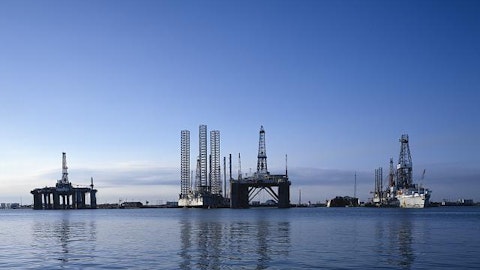Fredrik Stene: And just a final follow-up in terms of the cash priority waterfall. You said that you would look for potential accretive investments and since this relates to the cash waterfall, I would kind of assume that you’re potentially looking at single assets transactions. But in a broader sense, are you also finding opportunities that you would consider paying for with your share at this point since it’s been doing a good run lately?
Simon Johnson: Fredrik, let me have a crack at that, it’s Simon. Look, I think we’re willing to consider anything from upgrades to buying stand-alone rigs to buying balance sheet. So I think the only thing that differs is the means of consideration that we would provide depending on the size of the transaction. So whether for small more discrete capital outlays, we’re going to fund that through cash where possible so that we minimize any potential dilution to our shareholders. When we start to look at larger, shall we say, more strategic combinations; then it’s more likely to be finance, if you like, on a relative share price type approach. So the key thing to understand though is we’re not going to know anything of that nature unless it compares favorably with the returns that would come from returning that cash to shareholders.
So these opportunities need to be competitive. We’re constantly calculating what our weighted average cost of capital is and we have investment thresholds and risk premiums depending on the type of project that we’re looking at. And within that sort of that process out of the back end, if we don’t come up with an efficient way to use that money in growth CapEx shall we say, then we’re going to return that capital to the shareholders. And what you’re seeing today is really just our first step in that process. If we don’t have a value accretable to deploy the money within the enterprise, we will return it to our shareholders in the manner that we’ve described. So hopefully, people will notice that this is just yet another data point that underlies our consistent reliability in delivering on what we promised to do.
At Seadrill, we execute on our plans and hopefully people see that broader message behind what we’ve announced today.
Operator: Our next question comes from David Smith from Pickering Energy Partners.
David Smith: I wanted to circle back to Samir’s comments about potential idle time to reposition rigs. I expect for most of the past 8 or 9 years you wouldn’t have been reimbursed for much more than the actual load cost. But I’m curious if you’re seeing operator willingness to compensate you for not just the actual expense of those loads, but the opportunity cost of that downtime?
Samir Ali: Dave, this is Samir. I’d say we’re trying to get that from clients. I’d say it’s still early days and there’s still some pushback on doing that. I think my comment was more, as Simon had stated, we want to try to put our rigs into regions and cluster them a little bit. So don’t be surprised if we try to cluster assets again and that’s what we were trying to allude to there.
David Smith: Absolutely, makes sense. Follow-up if I may. We’ve seen some indication of IOCs looking at multiyear terms for drillships with ‘25 start dates. I’m curious how you’re thinking about pricing relative to leading-edge rates for work where the rate is fixed 4, 5, maybe 6 years from now. But also curious if you think there is operator appetite for signing term with indexed pricing and that that mechanism would be of interest to you.
Samir Ali: Yes. So we’re open to looking at index pricing. Also I think a big thing for us given the inflationary market we’re in, we’re also looking for inflation protection costs increasing and making sure that we still generate the margin we expect to generate. I’d say for us when we’re looking at contracts starting ‘25 or ‘26 that are longer dated, we can be creative and we can be flexible. And I think the key there is trying to be creative, right, and looking out what is the drilling market going to be in 2030. And we’ve got some innovative ways that we’ve started looking at it and I think we’re getting some traction with clients on that as well.
David Smith: Looking forward to what those are. Thank you very much.
Operator: [Operator Instructions] Our next question comes from Eddie Kim from Barclays.
Eddie Kim: I found your comment about long-dated contracts currently being the exception rather than the rule quite interesting. It feels almost contrary to what we’ve been seeing recently. We’ve seen a handful of multiyear contracts out of West Africa and offshore Mexico for example and I believe many of your peers had talked about certain operators looking to secure rigs outside the scope of certain specific projects. So could you provide just any color with regards to that comment? Is this a change from what you’ve been seeing over the past 6 months or so or has this been your view all along? Just any additional commentary or color on that comment?




